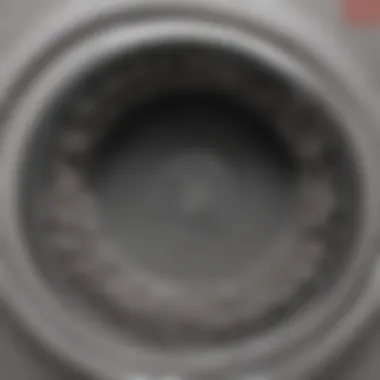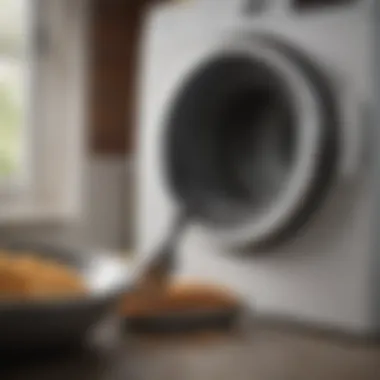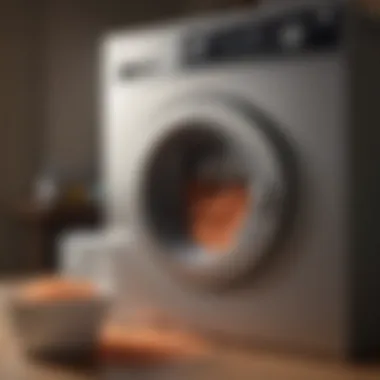Eliminating Lint from Your Dryer: A Comprehensive Guide


Intro
Maintaining your dryer is not just a chore; it is essential for your appliance's longevity. Lint buildup in your dryer can lead to reduced efficiency and even potential fire hazards. Knowing how to eliminate lint effectively can significantly improve your laundry experience. This guide provides a thorough understanding of lint accumulation and its risks, alongside practical techniques for its removal.
Regular cleaning helps not only in prolonging the life of the dryer but also ensures no disruption in daily laundry duties. Readers will find the insights presented here on lint hazards, cleaning methods, and preventive tips invaluable. Knowledge is power when it comes to appliance maintenance.
Understanding Lint Accumulation
Lint forms from clothing fibers that shed during the drying process. Over time, these fibers build up within the dryer itself and in the vent system. Several factors contribute to lint production:
- Fabric Types: Some fabrics produce more lint than others, such as cotton or fleece.
- Drying Conditions: Overloading the dryer can hinder airflow, leading to increased lint.
It is crucial to recognize these factors for effective cleaning.
The Dangers of Lint Buildup
Lint accumulation poses significant dangers. Here are some critical points to consider:
- Fire Hazard: Lint is highly flammable and can ignite if it reaches high temperatures.
- Reduced Efficiency: A lint-clogged dryer takes longer to dry clothes, wasting energy and time.
Regularly removing lint is not just about appliance care; it is about ensuring safety in your home.
Safe Cleaning Practices
Understanding how to safely clean lint from your dryer is key. Here are recommended methods:
- Clean the Lint Trap: After every use, check and remove lint from the trap.
- Vacuum the Dryer Drum: Use a vacuum extension to reach deep inside and remove any lint.
- Inspect the Venting System: Regularly check the vent tube for clogs, and clean as necessary. A blocked vent can increase drying time.
- Tip: Wash the lint filter with soap and water every month to remove residue.
Recommended Tools for Maintenance
A few simple tools can make the lint-cleaning process more effective:
- Vacuum Cleaner with Hose: This is crucial for thorough cleaning.
- Brush Kit for Dryer Lint: These brushes are designed to help clean the vent effectively.
- Lint Roller: Handy for quick clean-ups in the dryer drum and surrounding areas.
Closure
In summary, eliminating lint from your dryer is a straightforward but essential task. Regular maintenance not only enhances the efficiency of your dryer but also promotes safety. By understanding lint accumulation and employing safe cleaning practices, users can ensure their dryer operates optimally for years to come. This guide equips you with all the knowledge you need to integrate these practices into your regular laundry routine.
Prolusion to Lint Buildup
Understanding lint buildup in your dryer is essential for maintaining its efficiency and longevity. Lint, made up of tiny fibers detached from clothes during washing and drying, accumulates within the dryer and can lead to various issues. The awareness of lint accumulation goes beyond basic appliance care; it is critical for ensuring safety and optimal performance.
Understanding Lint
Lint consists mainly of textile fibers that loosen from clothing and fabrics during drying. It is a natural byproduct of the drying process, where fabrics undergo agitation and heat. Each type of fabric produces a different amount of lint. For instance, cotton often contributes more lint than synthetic materials. While some lint is inevitable, the quantity can vary greatly depending on laundry habits and fabric choices.
By recognizing what lint is and its origins, users can better address the buildup in their dryers. The simplicity of the concept belies its importance. Over time, neglecting lint buildup can lead to more serious problems, including reduced efficiency and increased fire hazards.
Sources of Lint in Laundry
Numerous sources contribute to lint accumulation in your dryer. Common culprits include:
- Cotton clothing: Items like towels and leggings release significant lint.
- Fleece and synthetics: These fabrics can also contribute fluffy lint particles.
- Old or worn fabrics: Age affects the structure of fabrics, leading them to shed more fibers.
- Load size: Overloading the dryer can restrict airflow, preventing lint from being properly vented.
Understanding these sources can help you adjust your laundry practices. Identifying lint-prone fabrics allows you to modify your washing and drying routines for better management of lint.
Impact of Lint on Drying Efficiency


Lint affects drying efficiency in several ways. As it accumulates in the lint trap and venting system, it restricts airflow necessary for effective drying. Restricted airflow can lead to:
- Longer drying times: Clothing will need to spend more time in the dryer to achieve the desired dryness.
- Increased energy costs: An ineffective drying cycle results in higher energy consumption.
- Wear and tear on the dryer: Overworking the dryer increases the potential for malfunctions over time.
If lint build-up continues unchecked, it becomes a fire hazard. The combination of heat and flammable lint can create dangerous situations in your home.
"Regular maintenance and lint removal are crucial not just for efficiency but also for safety."
Preventive Measures for Lint Accumulation
Preventing lint accumulation is essential for operating a dryer efficiently and safely. Lint buildup can lead to poor drying performance, increased energy consumption, and even fire hazards. By taking steps to minimize lint generation and accumulation, you ensure that your dryer operates optimally and your laundry remains fresh.
One of the core aspects of lint prevention involves making informed choices, starting from the types of fabrics used in your laundry routine. Certain materials are more prone to shedding lint, which can contribute to the overload of lint in your dryer. Understanding the source of lint is crucial in managing its presence.
Choosing Lint-Free Fabrics
When selecting laundry items, choosing lint-free fabrics is a vital step. Fabrics such as polyester or nylon tend to produce less lint compared to natural fibers like cotton or wool. Avoiding materials that are known for their lint-producing characteristics can significantly reduce the amount of lint you encounter.
Instead of relying solely on blankets or bath towels made of high-lint materials, consider incorporating garments made from synthetic fibers into your laundry. Additionally, paying attention to how new items behave in the dryer can help in making smarter fabric choices in the future.
Proper Loading Techniques
Another preventive measure involves proper loading techniques in the dryer. Overloading the dryer not only reduces efficiency but also heightens the risk of lint clumping and accumulating in various parts of the machine. It is recommended to load the dryer with a balanced and appropriate mix of items.
Arranging similar-sized items together can help the dryer function effectively, allowing for even tumbling and circulation of air.
Try to follow load size recommendations specified by the manufacturer. This prevents blockages and lint buildup in the lint trap and ducts.
Regular Cleaning of Dryer's Lint Trap
Regular cleaning of the dryer’s lint trap is crucial. It is important to clean the lint trap before or after every load. By doing this, you enhance airflow and optimize drying efficiency. Blocked lint traps can slow drying times, leading to extra wear on your dryer.
To clean the lint trap effectively, first, remove it from the dryer and use your fingers or a soft brush to gather the lint. Ensure there are no residues left behind. Moreover, consider deeper cleaning every couple of months, using soap and water to wash the trap completely. This attention to detail in maintenance helps in preventing future lint issues.
"Regular maintenance of your dryer is not just about performance; it is also about safety and long-term efficiency."
In summary, focusing on preventive measures like choosing lint-free fabrics, employing proper loading techniques, and consistently cleaning the lint trap contributes significantly to minimizing lint accumulation. This proactive approach offers satisfaction in achieving a cleaner, safer, and more efficient laundry experience.
Tools Required for Lint Removal
Maintaining a lint-free dryer is essential. Having the right tools can enhance the efficiency of the cleaning process, prolonging the lifespan of the dryer. This section focuses on the primary tools needed for effective lint removal, ensuring that readers understand both the importance and the practical applications of these tools.
Lint Traps and Filters
Lint traps and filters are the first line of defense against lint accumulation. These devices collect lint that sheds from clothes during the drying process. Regularly checking and cleaning the lint trap before and after each use minimizes fire hazards and improves drying efficiency. A clogged lint trap can significantly prolong drying time, wasting energy. Ensuring your lint trap is clean can also prevent fibers from bypassing the filter and entering the dryer vent, which can lead to more severe blockages in the future.
Here are some key considerations regarding lint traps:
- Material Quality: Invest in high-quality lint traps that are durable and fit well with your dryer model.
- Ease of Cleaning: Opt for traps that are easy to remove and clean.
- Compatibility: Always check that the size and design of the trap match your specific dryer brand.
Cleaning Brushes and Tools
Cleaning brushes are indispensable for accessing hard-to-reach areas. Lint can accumulate in various nooks and crannies of a dryer that a simple lint trap cannot reach. Specialized dryer cleaning brushes have long, flexible handles that allow the user to effectively remove accumulated lint from the vent and other difficult areas.
Several tools could aid in the effective removal of lint:
- Vent Cleaning Brush: These are specifically designed to tackle lint buildup in the dryer vent.
- Flexible Hose Attachment: Allows for connection to a vacuum cleaner to reach deep inside the ductwork.
- Handheld Lint Removal Brush: Handy for quick cleanups around the lint trap and dryer exterior.
Having the right brushes will not only help keep your dryer running efficiently but also contribute to a safer environment in your home.
Vacuum Cleaners for Efficient Cleaning


Using a vacuum cleaner for lint removal is an effective strategy, particularly for accessing larger lint accumulations in the duct system. Utilizing a vacuum allows homeowners to remove lint quickly and efficiently, reducing reliance on manual cleaning techniques alone.
Key reasons for using a vacuum include:
- High Suction Power: A vacuum cleaner can remove more lint than brushing techniques alone.
- Efficiency: Anticipating lint buildup in both the dryer and vent ensures thorough cleaning.
- Time-Saving: Vacuuming can often be done in less time than using traditional manual cleaning methods.
For best results, it is advisable to choose a vacuum with powerful suction and compatible attachments that can fit into dryer ducts. Regular vacuuming, combined with proper brushing methods, ensures the dryer not only operates efficiently but remains safe for use.
Effective Lint Removal Techniques
Lint accumulation in dryers can severely affect their performance and safety. Understanding effective lint removal techniques is crucial. These methods help maintain the dryer’s efficiency, prolong its lifespan, and minimize fire risks associated with lint buildup.
Cleaning the Lint Trap
Cleaning the lint trap is the first step in an effective lint removal process. The lint trap, usually located just inside the dryer door, collects lint and debris from clothes as they dry. Regular cleaning after each load prevents lint from clogging. This step ensures maximum airflow and helps dry clothes faster.
To clean the lint trap, remove it from its slot. Use your fingers to remove lint or gently brush it off with a soft brush. Wash the lint trap with warm soapy water periodically. This removes residue from fabric softeners that may affect airflow. Ensure the trap is completely dry before placing it back in the dryer.
Vacuuming the Lint Duct
Vacuuming the lint duct is a more comprehensive approach to lint removal. The lint duct is where lint travels between the drum and external vent. Over time, lint can accumulate here, creating blockages that affect efficiency. If your dryer isn’t drying clothes thoroughly, this may be a sign that the duct needs attention.
To vacuum the lint duct, turn off and unplug your dryer. Disconnect the duct from the back of the dryer using a screwdriver. Use a vacuum with a long hose attachment to reach inside the duct and remove lint. It's advisable to vacuum both the inside of the duct and the external vent. This technique enhances airflow and helps prevent future lint buildup.
Using a Dryer Cleaning Kit
A dryer cleaning kit simplifies the lint removal process. These kits contain specialized tools designed to reach areas that are hard to access. A typical kit might include brushes and attachments that fit into the duct and vent systems.
Using a dryer cleaning kit is straightforward. First, read the instructions specific to your kit. Generally, you insert the brush into the duct and gently pull it out to remove lint. Some kits even include a vacuum adapter to help suck out lint directly. Regular use of a cleaning kit can significantly reduce the chance of lint accumulation in hard-to-reach areas.
Maintaining a clean lint trap, duct, and using a cleaning kit can greatly enhance the efficiency and safety of your dryer.
By integrating these effective lint removal techniques into your dryer maintenance routine, you will ensure better performance and safety of your appliance.
Addressing Severe Lint Accumulation
Addressing severe lint accumulation is a critical aspect of maintaining your dryer and ensuring it functions safely and efficiently. When lint builds up excessively, it can lead to numerous problems. The most alarming issue is the increased risk of fire hazards, as lint is highly flammable. Furthermore, severe lint buildup can drastically reduce the drying efficiency of your appliance, leading to longer drying times and increased energy consumption. Understanding how to identify and manage these lint problems is essential for the safety of your home and the longevity of your clothes dryer.
Identifying Warning Signs of Lint Blockage
Recognizing the warning signs of lint blockage is the first step toward preventing severe accumulation. Some common indicators include:
- Decreased drying performance: If your clothes feel damp or take a lot longer to dry than usual, it may be a signal that lint is obstructing airflow.
- Overheating dryer: If the exterior of your dryer feels hot to the touch during or after a cycle, lint build-up could be restricting proper ventilation.
- Unusual odors: A burning smell or a musty odor may arise from lint accumulating in the ducts, which can indicate a pressing problem.
- Increased lint on clothes: If you notice an unusual amount of lint on your laundry after drying, the lint trap may be overwhelmed, or ducts may be blocked.
Identifying these signs early is vital. Prolonged neglect can lead to expensive repairs or even a hazardous situation.
Professional Cleaning Services
When severe lint accumulation occurs, hiring professional cleaning services is a wise consideration. These specialists often possess equipment and knowledge beyond that of the average homeowner. Professional services typically include:
- Thorough inspections: Experts can locate lint deposits in less accessible areas that may be missed during routine cleaning.
- Advanced cleaning techniques: Professionals use specialized tools to effectively remove lint from ducts and traps.
- Safety compliance: Hiring trained technicians ensures that the work meets safety regulations, reducing liability for the homeowner.
Opting for professional cleaning can ultimately save you money and stress. It is recommended to have your dryer professionally cleaned annually, particularly if you encounter frequent lint issues.
Replacing Worn-Out Lint Traps
Replacing worn-out lint traps is another essential task in addressing severe lint accumulation. Lint traps can deteriorate over time or become less effective. Signs that your lint trap needs replacement include:
- Physical damage: Cracks or signs of age can hinder its performance.
- Inconsistent performance: If cleaning the lint trap does not yield better drying outcomes, it may be time for a replacement.
- Unusual gaps: A poorly fitting or damaged lint trap can allow lint to escape, leading to blockages elsewhere.
When selecting a new lint trap, consider high-quality options from well-reviewed brands. Ensure that the trap fits securely in your dryer model to prevent future issues. Regular inspections and replacing worn components contribute to the overall effectiveness of your lint management efforts.


Keeping a close eye on lint accumulation can prevent minor issues from escalating into major problems.
Lint and Home Safety Concerns
Lint buildup in dryers is a critical issue that extends beyond mere inconvenience. The accumulation of lint can lead to serious safety risks, including fire hazards. Understanding these risks is essential for every household that utilizes a dryer. This section delves into the dangers of lint and provides important guidelines for maintaining dryer safety to protect your home effectively.
Fire Hazard Risks Associated with Lint Buildup
Lint is highly flammable. When it collects in the dryer’s lint trap, ducts, and vents, it can create a significant fire hazard. According to the National Fire Protection Association, dryers cause approximately 15,000 fires annually in the United States, largely due to lint accumulation. The heating elements in dryers can ignite accumulated lint, resulting in catastrophic fires. Thus, a clean dryer is not just about efficiency; it is fundamentally about safety.
Some contributing factors to increased fire risks include:
- Ventilation Blockages: If the lint is not cleared regularly, it can obstruct airflow, increasing the dryer’s temperature and heightening fire risk.
- Faulty Equipment: Old or malfunctioning dryers may not only accumulate lint more but also fail to detect overheating, amplifying danger.
- Neglected Maintenance: Many users overlook essential maintenance tasks such as cleaning the venting system, which can lead to lint buildup over time.
To summarize, being aware of these risks helps in taking proactive measures to ensure a safe laundry environment. Regular lint removal greatly decreases the likelihood of fire hazards associated with dryer use.
Safety Tips for Dryer Maintenance
Maintaining a dryer involves several straightforward practices that significantly enhance safety. Here are some valuable tips to ensure your dryer remains safe for use:
- Clean the Lint Trap After Each Use: Always remove and clean the lint filter after every load of laundry. This one simple action helps prevent lint accumulation that can lead to fires.
- Check the Venting System Regularly: Inspect the duct and vent regularly for any clogs or blockages and clean them to ensure proper airflow.
- Avoid Overloading the Dryer: Overloading increases the chance of lint accumulation and can strain the dryer’s mechanism. Stick to load capacity recommendations.
- Dryer Location Awareness: If your dryer is in a closet or tight space, ensure there is enough ventilation. Poor ventilation can contribute to overheating and lint buildup.
- Schedule Professional Inspections: Consider arranging for a professional dryer vent cleaning service every year or two. They have tools to remove lint from areas that may be hard to reach.
"Prevention is always better than cure. Regular maintenance of your dryer can provide peace of mind and enhance safety in your home."
Safety is paramount when it comes to dryer use. By implementing these practices, you can significantly reduce the risk of fire and contribute to a safer home environment. Staying diligent about lint management is an investment in your household’s safety.
Long-Term Strategies for Lint Prevention
In maintaining your dryer, long-term strategies for lint prevention are essential. They help ensure your dryer operates efficiently and safely over time. These strategies minimize lint accumulation, reduce wear on the appliance, and promote safe laundry practices. Addressing lint buildup before it becomes an issue is more effective and efficient than dealing with the consequences later. By implementing preventive measures, you can extend the lifespan of your dryer while enhancing its performance.
Routine Maintenance Schedule
Establishing a routine maintenance schedule is an effective way to prevent lint buildup. Regular cleanings not only address visible lint but can also help in reducing hidden accumulations. Here are some key components to consider:
- Weekly lint trap cleaning: Make it a habit to clean the lint filter after every load. This is imperative and should not be skipped.
- Monthly duct inspections: Check dryer ducts for blockages or buildup. Ensure there are no restrictions, as this can drastically impact drying times.
- Annual professional servicing: Consider hiring a professional to service your dryer at least once a year. They can conduct thorough inspections and cleanings that may not be achievable at home.
Maintaining a consistent schedule will help keep your dryer in top condition, reducing the risk of significant lint-related issues.
Using Dryer Sheets and Alternatives
Dryer sheets can provide a dual function in your laundry routine. While they are common for reducing static cling and adding fragrance, they also affect lint buildup. Here are some considerations:
- Lint reduction: Some dryer sheets can help reduce lint. Choose brands that specifically advertise a reduction in lint. Experiment with different types to find which work best for your laundry.
- Alternatives: If you prefer non-chemical methods, consider using wool dryer balls. They are a sustainable option and assist in separating clothes in the dryer, improving air circulation and reducing lint.
When using dryer sheets or alternatives, always remember to clean the lint trap effectively after each dryer session. It can help maximize the potential benefits of these items, keeping your appliance functioning efficiently.
Keeping on top of lint prevention not only improves dryer efficiency but also enhances safety. A well-maintained dryer is less likely to pose fire hazards associated with lint buildup.
Finale
In this final section, we underscore the significance of understanding and practicing effective lint management in your dryer. Lint buildup can profoundly affect both the efficiency of your appliance and the safety of your home. The practices we discussed throughout the article not only aim to enhance the performance of your dryer but also to minimize the potential fire hazards associated with neglecting this essential task.
Summary of Best Practices
To recap, several best practices emerge from our exploration of lint elimination techniques. Here are the most critical points:
- Regular Inspection: Frequently check the lint trap before and after every drying cycle.
- Thorough Cleaning: Clean the lint trap and the ductwork at regular intervals to prevent obstruction.
- Use Appropriate Tools: Utilize vacuum cleaners and dryer cleaning kits for comprehensive lint removal.
- Choose Fabrics Wisely: Opt for fabrics that produce less lint to begin with, therefore minimizing the amount that can accumulate.
These actions contribute to a cleaner dryer, better drying performance, and improved appliance lifespan.
Reflection on Maintenance Importance
Reflecting on the importance of maintenance, it becomes evident that a proactive approach is essential. Routine maintenance reduces the risk of malfunction and ensures that your dryer operates effectively. Establishing a maintenance schedule can help you stay on track and recognize any signs that require your immediate attention. Investing a small amount of time in lint management not only preserves your appliance but safeguards your home against potential fires caused by lint accumulation. Thus, recognizing the escaladed importance of dryer maintenance can lead to a safer and more efficient laundry experience.
"Preventive maintenance is key in avoiding costly repairs and ensuring safety in your home."
Understanding and implementing these practices keeps your dryer functioning at its best, prolongs its life, and ensures the safety of all in your household.







